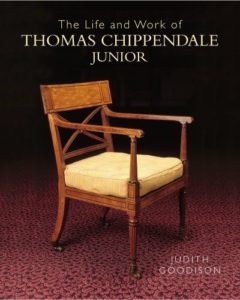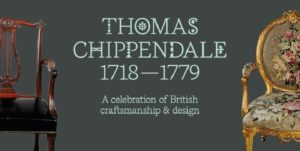 While we celebrate this year the tercentenary of Thomas Chippendale, it must be remembered that it is the birth of Thomas Chippendale the elder, and that his son Thomas Chippendale the younger was involved in the workshop from around 1770. Indeed, it is from information that survives from the time of the younger that we know much of what we do, particularly about the shop itself.
While we celebrate this year the tercentenary of Thomas Chippendale, it must be remembered that it is the birth of Thomas Chippendale the elder, and that his son Thomas Chippendale the younger was involved in the workshop from around 1770. Indeed, it is from information that survives from the time of the younger that we know much of what we do, particularly about the shop itself.
However, as the elder died in 1779 after a couple of years of inactivity due to ill health, it is to Thomas Chippendale the younger we must look for the inspiration, draughtsmanship, and craft that produced some of the workshops most notable productions in the last quarter of the 18th century. After basically two centuries of inattention, there has recently at long last been significant scholarly attention paid to his work.
A bit of chronology is worth inserting here, with the work of Thomas Chippendale the elder spanning the years from circa 1750 through a few years before his death in 1779, while the tenure of the younger was significantly longer, from about 1770 until about 1821, carrying on despite the firm’s bankruptcy in 1804. Chippendale junior died in 1822.
The lack of attention paid to the younger was possibly the result of the phenomenal attention paid posthumously to the elder. Through the 19th and 20th centuries ‘Chippendale’ became a byword for anything in the style of the English decorative arts of roughly the middle of the 18th century. The mid-18th century rococo of the Director achieved a revival in the early years of the 19th century, with the publication of John Weale’s A Collection of Ornamental Designs, with the subtitle ‘chiefly after the designs of Thomas Chippendale’. Bowett notes that despite the subtitle the book didn’t contain a single plate by Thomas Chippendale.
This revivalism continued apace through the century, with every manufacturer offering something in a traditional style that was then labeled ‘Chippendale’. What might be regarded as full-on institutional sanction came in 1905 with the installation of a full-length statue of Thomas Chippendale installed in the façade of the Victoria & Albert Museum.
Although Chippendale’s Director in various editions and reprints was widely distributed, including colonial America, it has seemed to me that American 18th century furniture with designs derived from the Director has significantly less to do with the perpetuation of Chippendale’s innovative designs than it does with what I’d term ‘trade speak’.
With the popularity of colonial furniture styles and colonial revivalism certainly during most of the last century, American dealers and collectors have habitually referred to any case or seating piece with a cabriole leg or any chair with a fan back as ‘Chippendale’. This sort of inaccurate shorthand continues with fulsome abandon, with the American ‘Antiques Roadshow’ on PBS replete with so-called experts repeating this imprecise shorthand on every episode. This underlines the ability of less sophisticated dealers, interior designers and novice collectors to then contact members of the accredited trade in art and antiques and ask for something ‘Chippendale’. What I find frustrating, and at other times mirthful, is the long discussion this then begs when we field such an enquiry, trying to achieve shall we say intellectual common ground. Mea culpa, I am not always as patient as I should be, and in trying to suss out what it is the client is actually seeking, I suspect I am characterized, not always sub rosa, as pedantic and snotty. Or, on second thought, perhaps I have actually been from time to time caught out, with my basic nature pedantic and snotty.
 Fortunately, Chippendale scholarship proceeds apace. This year’s excellent tercentenary exhibition at Leeds City Museum accompanied by a comparably excellent catalog knowledgeably weaves together disparate strands of information about his early life and career, the various editions of the Director, notable commissions, and his legacy.
Fortunately, Chippendale scholarship proceeds apace. This year’s excellent tercentenary exhibition at Leeds City Museum accompanied by a comparably excellent catalog knowledgeably weaves together disparate strands of information about his early life and career, the various editions of the Director, notable commissions, and his legacy.
